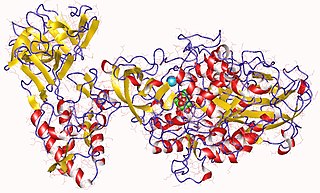Related Research Articles

Starch or amylum is a polymeric carbohydrate consisting of numerous glucose units joined by glycosidic bonds. This polysaccharide is produced by most green plants for energy storage. Worldwide, it is the most common carbohydrate in human diets, and is contained in large amounts in staple foods such as wheat, potatoes, maize (corn), rice, and cassava (manioc).

Cycloamyloses are cyclic α-1,4 linked glucans comprising dozens or hundreds of glucose units. Chemically they are similar to the much smaller cyclodextrins, which are typically composed of 6, 7 or 8 glucose units.
Isomaltase is an enzyme that breaks the bonds linking saccharides, which cannot be broken by amylase or maltase. It digests polysaccharides at the alpha 1-6 linkages. Its substrate, alpha-limit dextrin, is a product of amylopectin digestion that retains its 1-6 linkage. The product of the enzymatic digestion of alpha-limit dextrin by isomaltase is maltose.

1,4-alpha-glucan-branching enzyme, also known as brancher enzyme or glycogen-branching enzyme is an enzyme that in humans is encoded by the GBE1 gene.
A glucan is a polysaccharide derived from D-glucose, linked by glycosidic bonds. Glucans are noted in two forms: alpha glucans and beta glucans. Many beta-glucans are medically important. They represent a drug target for antifungal medications of the echinocandin class.
In enzymology, a 1,4-alpha-glucan 6-alpha-glucosyltransferase is an enzyme that catalyzes the chemical reaction that transfers an alpha-D-glucosyl residue in a 1,4-alpha-D-glucan to the primary hydroxyl group of glucose or 1,4-alpha-D-glucan.
In enzymology, an amylosucrase is an enzyme that catalyzes the chemical reaction
In enzymology, a cellulose synthase (GDP-forming) is an enzyme that catalyzes the chemical reaction
In enzymology, a dextransucrase is an enzyme that catalyzes the chemical reaction
In enzymology, a dextrin dextranase is an enzyme that catalyzes the chemical reaction

In enzymology, an alternansucrase is an enzyme that catalyzes a chemical reaction that transfers an alpha-D-glucosyl residue from sucrose alternately to the 6- and 3-positions of the non-reducing terminal residue of an alpha-D-glucan, thereby creating a glucan with alternating alpha-1,6- and alpha-1,3-bonds. The name "alternan" was coined in 1982 for the glucan based on its alternating linkage structure.

In enzymology, a cyclomaltodextrin glucanotransferase is an enzyme that catalyzes the chemical reaction of cyclizing part of a 1,4-alpha-D-glucan molecule through the formation of a 1,4-alpha-D-glucosidic bond. They are bacterial enzymes belonging to the same family of the α-amylase specifically known as glycosyl-hydrolase family 13. This peculiar enzyme is capable of catalyzing more than one reaction with the most important being the synthesis of non-reducing cyclic dextrins known as cyclodextrins starting from starch, amylose, and other polysaccharides.
In enzymology, a NDP-glucose—starch glucosyltransferase is an enzyme that catalyzes the chemical reaction

In enzymology, a starch synthase is an enzyme that catalyzes the chemical reaction
In enzymology, a sucrose-1,6-alpha-glucan 3(6)-alpha-glucosyltransferase is an enzyme that catalyzes the chemical reaction
In enzymology, a xyloglucan:xyloglucosyl transferase (EC 2.4.1.207) is an enzyme that catalyzes the chemical reaction in which a beta-(1,4) bond in the backbone of a xyloglucan in broken; the xyloglucanyl segment is then transferred to the O4 of the non-reducing terminal glucose residue of either xyloglucan or an oligosaccharide thereof.
In enzymology, an oligosaccharide 4-alpha-D-glucosyltransferase is an enzyme that catalyzes the chemical reaction in which the non-reducing terminal alpha-D-glucose residue is transferred from a 1,4-alpha-D-glucan to the 4-position of an alpha-D-glucan. This enzyme is useful in hydrolyzing oligosaccharides.

α-Glucans (alpha-glucans) are polysaccharides of D-glucose monomers linked with glycosidic bonds of the alpha form. α-Glucans use cofactors in a cofactor site in order to activate a glucan phosphorylase enzyme. This enzyme causes a reaction that transfers a glucosyl portion between orthophosphate and α-I,4-glucan. The position of the cofactors to the active sites on the enzyme are critical to the overall reaction rate thus, any alteration to the cofactor site leads to the disruption of the glucan binding site.

Neopullulanase is an enzyme of the alpha-amylase family with systematic name pullulan 4-D-glucanohydrolase (panose-forming). This enzyme principally catalyses the following chemical reaction by cleaving pullulan's alpha-1,4-glucosidic bonds:

Steven M. Smith is Emeritus Professor of Plant Genetics and Biochemistry at the University of Tasmania in Australia and Chief Investigator in the Australian Research Council Centre of Excellence for Plant Success in Nature and Agriculture.
References
- ↑ Critchley, Joanna H.; Zeeman, Samuel C.; Takaha, Takeshi; Smith, Alison M.; Smith, Steven M. (2001-04-01). "A critical role for disproportionating enzyme in starch breakdown is revealed by a knock-out mutation in Arabidopsis". The Plant Journal. 26 (1): 89–100. doi: 10.1046/j.1365-313x.2001.01012.x . ISSN 1365-313X. PMID 11359613.
- ↑ Chia, Tansy; Thorneycroft, David; Chapple, Andrew; Messerli, Gaëlle; Chen, Jychian; Zeeman, Samuel C.; Smith, Steven M.; Smith, Alison M. (2004-03-01). "A cytosolic glucosyltransferase is required for conversion of starch to sucrose in Arabidopsis leaves at night". The Plant Journal. 37 (6): 853–863. doi: 10.1111/j.1365-313X.2003.02012.x . ISSN 1365-313X. PMID 14996213.
- ↑ Takaha, Takeshi; Yanase, Michiyo; Takata, Hiroki; Okada, Shigetaka; Smith, Steven M. (1996-02-09). "Potato D-enzyme Catalyzes the Cyclization of Amylose to Produce Cycloamylose, a Novel Cyclic Glucan". Journal of Biological Chemistry. 271 (6): 2902–2908. doi: 10.1074/jbc.271.6.2902 . ISSN 0021-9258. PMID 8621678.
- Hehre EJ (1951). "Enzymic synthesis of polysaccharides: a biological type of polymerization". Advances in Enzymology and Related Areas of Molecular Biology. Advances in Enzymology - and Related Areas of Molecular Biology. 11: 297–337. doi:10.1002/9780470122563.ch6. ISBN 978-0-470-12256-3. PMID 24540594.
- Lukomskaya, I. S. (1959). "Синтез oligosaccharides с alpha-1,6-bonds приготовлениями фермента от печени и мускула" [Synthesis of oligosaccharides with alpha-1,6-bonds by enzyme preparations from liver and muscle]. Doklady Akademii Nauk SSSR (in Russian). 129: 1172–1175.
- Pazur JH, Okada S (1968). "The isolation and mode of action of a bacterial glucanosyltransferase". J. Biol. Chem. 243 (18): 4732–8. PMID 4972097.
- Walker GJ, Whelan WJ (1959). "Synthesis of amylose by potato D-enzyme". Nature. 183 (4653): 46. Bibcode:1959Natur.183...46W. doi: 10.1038/183046a0 . PMID 13622683. S2CID 4289861.
- Whelan WH (1971). "Enzymic explorations of the structures of starch and glycogen". Biochem. J. 122 (5): 609–622. doi:10.1042/bj1220609. PMC 1176828 . PMID 5001952.